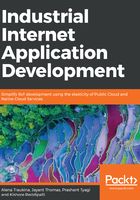
上QQ阅读APP看书,第一时间看更新
Challenges in handling IIoT data
There are four major challenges in handling IIoT data that we describe here, and also touch upon how enterprises should prepare themselves to address these challenges. In the next section, we will describe the architecture that will help address these challenges:
- The following six characteristics of data captured by IIoT solutions need to be managed in order to make these solutions effective for enterprises:
- Volume (data at rest): Terabytes, exabytes, petabytes, and zettabytes of data.
- Velocity (data in motion): Capturing and processing streaming data in seconds or milliseconds to meet needs or demands.
- Variety (data in many forms): Structured, unstructured, text, multimedia, video, audio, sensor data, meter data, HTML, text, emails, and so on.
- Veracity (data in doubt): Uncertainty due to data inconsistency and incompleteness, ambiguities, latency, deception, model approximations, accuracy, quality, truthfulness, or trustworthiness.
- Variability (data in change): The different ways in which data may be interpreted; different questions require different interpretations. Data flows can be highly inconsistent with periodic peaks.
- Value (data for cocreation): The relative importance of different data to the decision-making process.
- As IIoT solutions generate increased amount of data from various devices, it becomes important that this data be managed in a way that can serve different personnel. The IIoT data will be used to generate reports for management; it can be used by data scientists to build and test their prediction models; or it can be used by field personnel who operate and maintain physical assets. The following figure depicts how this puts strain on the existing enterprise data tools:

- As depicted in the figure, one static model on top of a traditional data warehouse handles limited data types and snapshots over small time frames. Hence, what is required is an approach to data management that will enable the building of custom schemas and models more effectively and dynamically, as depicted here:

- The existing solutions in enterprises are not geared to support this kind of usage. Moreover, they are a collection of independent tools and technologies in the existing enterprise environment that lead to repetition and extra work when processing this data. This leads to inefficiencies and time lags in getting to the actual analytics that need to be done on the data collected by the IIoT solutions. Hence, we need a more integrated approach to data management that will lead to reduced time and costs, and more agile ways of handling this ever-increasing data workload. The following diagram shows this, highlighting the need for an integrated data platform to achieve this goal. This will help us achieve efficiency and cost-effectiveness, as well as handling the six characteristics of data we mentioned before:

- The data collected by IIoT solutions needs to address different types of use cases and the way to address these different types of use cases will differ. Hence, appropriate technologies will need to be used and supported, enabling each of the different use cases. We can define four high-level use case patterns, which cover most, if not all of the use cases that we will encounter in the IIoT world. The following figure provides a description of these patterns and the relevant details:

The next sections describe what kind of data architecture will help us address the four challenges that we have described in this section.